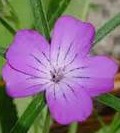
Corncockle is an upright annual belonging to the carnation family, Caryophyllaceae, that also includes pinks, baby’s breath, and campion. It is native to Europe where it grows in disturbed sites such as fields and roadsides, but is now common in North America. It was considered a weed of wheat fields until the twentieth century when agricultural practices changed and it is now cultivated as an ornamental. The plant grows 1-3′ tall and has a simple or sparsely branched stem carrying gray-green, opposite leaves that are 3-5″ long, narrowly lanceolate and carried upright close to the stem. Both the stem and leaves are covered with silky white hairs. The 5-petaled flowers are trumpet-shaped, magenta with black striping, and about one to two inches across. In summer, they appear singly at the ends of stiff stems that sway gently in the breeze and are subtended by narrow sepals that are longer than the petals. The light brown seed capsules open by 5 teeth and release many small pitted black seeds. Plants readily self-sow. An excellent choice for a cottage garden and a good cut flower. The genus name, Agrostemma, comes from the Greek words agros, meaning field, and stemma, meaning garland.
Type: Annual
Bloom: Magenta, trumpet-shaped, 1-2” across, singly on stiff stems in summer
Size: 1-3′ H x 11′ W
Light: Full sun
Soil: Poor, dry, well-drained
Hardiness: Not applicable
Care: Low maintenance
Pests and Diseases: None of significance
Propagation: Seed in situ
Companion Plants: Cornflower, poppies, lavender, marigolds, daisies, pinks (Dianthus)
Outstanding Selections:
‘Milas” (dark plum-pink flowers
‘Ocean Pearl’ (white)
‘Pink Pearl’ (pale pink flowers)